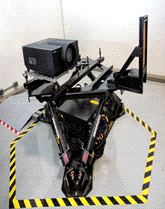Inkjet & Digital Printing
STRATASYS 3D PRINTING HELPS HYPHEN PROJECT EVERYTHING BETTER, INCLUDING HUMAN VEINS

Wednesday 20. November 2013 - Stratasys FDM and PolyJet 3D printing used to test and perfect commercial digital projectors plus devices that project human veins
Stratasys Ltd. (NASDAQ: SSYS), a manufacturer of 3D printers and materials for personal use, prototyping, and production, today announced that Hyphen, the in-house rapid prototyping center of Christie Digital Systems, is utilising Stratasys 3D printing to rigorously test commercial digital projectors and explore new industries and applications.
According to Mark Barfoot, Managing Director at Hyphen, employing both Stratasys FDM and PolyJet 3D printing technologies has enabled the product development team to focus on ensuring customers get the perfect design before the final mold is produced.
“The main benefit for Hyphen is that when we go to market, the product is manufactured right the first time, ensuring our customers get something that has been optimised specifically for them. We’ve seen a real mind-set change in our engineers. They are no longer willing to live with one prototype and hope it works, but instead are now iterating daily to ensure they get the optimum design.”
With an in-house environmental testing facility, Hyphen puts its 3D printed prototypes through the paces including testing with extreme heat and vibration, enabling the identification of potential field failures or other issues early in the product development cycle.
“The Stratasys FDM process creates functional prototypes that have high heat deflection temperatures and exceptional chemical and solvent resistance, which is essential for us, as some projectors need products that must withstand very high temperatures,” commented Barfoot. “The materials are an exact match of the final product, so whether we are doing vibration or drop-testing, EMI, or thermal, they will behave very similar to the final injection molded parts.”
For more rubber-like materials, the company turned to Stratasys’ PolyJet-based Connex multi-material 3D printing technology, which enables Hyphen to combine rigid and flexible material properties.
“We are seeing more and more companies combining PolyJet and FDM 3D printed parts in the same products – enabling true functional realism during the design phase,” said Bruce Bradshaw, Director of Marketing, Stratasys. “By producing working prototypes that can be tested in extreme conditons, manufacturers can more easily evaluate product features and continue to make iterative changes until the optimal design is achieved.”
For the medical sector, Hyphen used both FDM and PolyJet 3D printing technologies to develop a prototype for the VeinViewer product, an innovative device that utilizes near-infrared light to detect subcutaneous blood and instantly projects a real-time image of the patient’s veins directly onto the surface of the skin. The VeinViewer imaging system is designed to help improve peripheral vascular access and is currently being used in facilities in over 40 countries around the world.
“Having the ability to introduce both technologies into the additive manufacturing process was critical to perfecting the design and functionality of this product,” says Barfoot. “Using the PolyJet system allowed us to trial the product using rubber overmolding and achieve a smooth surface finish, which gave us an accurate prototype to test with nurses early on in the process. With the FDM technology we were able to build functional parts, allowing us to conduct drop tests well before we got to tooling.”
